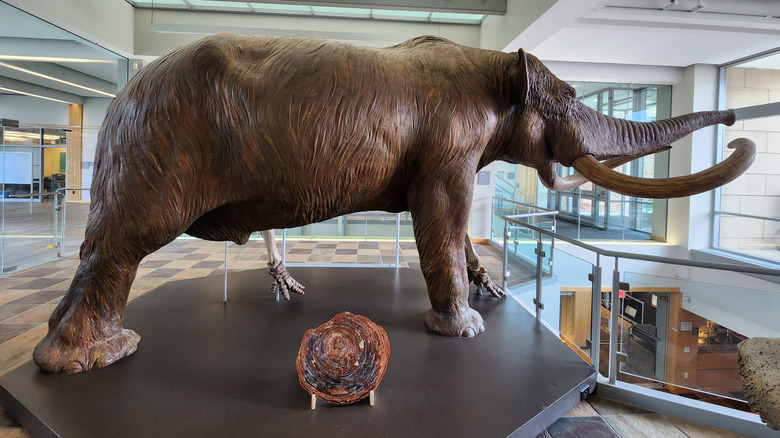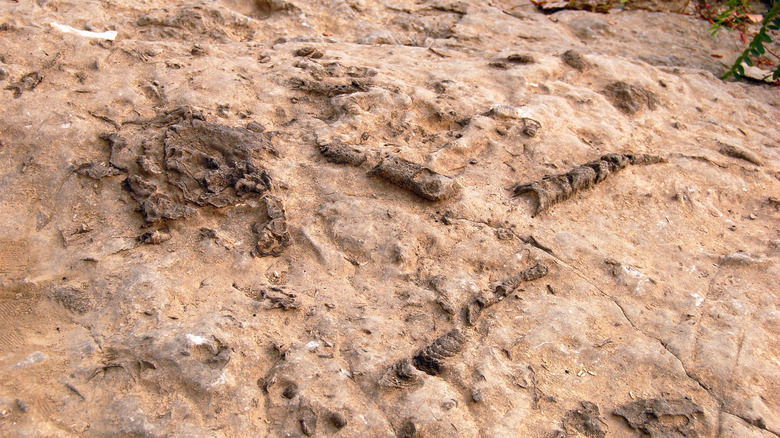How The Mastodon Became Indiana's State Fossil
At some point, you've probably seen depictions of mastodons, the huge-toothed, mammoth-like creatures that roamed the planet from around 23 million years ago up until about 11,700 years ago. Fossil evidence of their existence has been uncovered all over the world — the creatures existed pretty much everywhere. Mastodon remains have been uncovered as far apart as South America and Iran, but the highest concentrations have been found in North America, where they are believed to have first evolved before making it to other continents.
Specifically, mastodons have long been associated with Indiana — the creature is even used as a sports mascot at Purdue University Fort Wayne. The state is also home to fossils of other extinct Ice Age creatures such as mammoths. But over the years, a multitude of mastodon fossils have been uncovered in the state, and they provide vital insights into the eras in which they were thriving. In fact, there have been mastodon remains found in every county of the region, totalling some 300 distinct specimens. And in recent years, the paleontological importance of Indiana's mastodon fossils paved the way for legislation that deemed it the official state fossil.
Choosing the state fossil
The naming of a state fossil is common all across the United States. Indeed, by 2022 there were only five states that didn't have one — Indiana among them. Surprisingly, the state had a difficult time passing legislation to adopt a state fossil.
When lawmakers previously met to establish Indiana's first state fossil, the choice was the crinoid. The small marine creature has also been found copiously throughout the state, but perhaps it didn't inspire lawmakers to push on with the bill. As former geology professor Stanley Totten, who was involved with the bill, later explained (per Louisville Public Media): "Indiana is noted for its fossils, but these are tiny marine organisms that don't get a lot of attention as far as being educational tools. It's the dinosaurs that capture their attention. And the mastodons, of course, fit into that as sort of Indiana's version of the dinosaur, even though it isn't one. The mastodon makes a statement."
After at least 10 years of debate among lawmakers and the paleontology community, the mastodon finally became Indiana's first state fossil on July 1, 2022. Representative Randy Frye, who authored the bill in question, claimed that he decided to push for the mastodon instead of the chinoid after seeing the imposing skeleton of one on display at Hanover College and realized its potential to inspire interest in paleontology.
Indiana: A valuable state for fossils
Mastodon fossils have been found at 150 sites throughout Indiana, especially in the northern parts of the state. The latest discovery was in 2019, when limbs, a tusk, and a skull fragment were unearthed in the sewer system in Seymour. The hope is that naming the mastodon as Indiana's official state fossil will spark inspiration in the minds of young Hoosiers. Ideally, they will come to realize that the prehistoric world is quite literally in the ground beneath their feet and be encouraged to engage in the world of fossils that in many ways remains deeply mysterious. As Randy Frye told Louisville Public Media, the legislation is meant to explain to kids that while dinosaurs such as the T. Rex didn't live in what became Indiana, "mastodons did." "They were right here, right where we are," he continued. "It's designed to stimulate the young mind to start digging, if you will, into science and trying to determine what was here before us."
In 2023, U.S. Senator Mike Braun forwarded a bill named the National Fossil Act to make Indiana's state fossil the official fossil of the United States. It was Braun's hope that this would further inspire young Hoosiers by highlighting the importance of the fossils found in their state to the wider world of paleontology. Whether scientists will attempt to bring the mastodon back as they have tried to do with the wooly mammoth remains to be seen.


